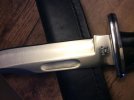- Joined
- Nov 11, 2002
- Messages
- 1,969
Hey guys - I just obtained this 5160 brass 119 off the exchange in nice condition. Number 45. While I'm normally a stainless blade preferer (is that a word?), I thought the brass 119 would be a good companion to my older standard one, even though I've not much real "need" for either, lol. They are a cool model though. I did notice the brass one has a little more heft to it.
My question though, is the marking in the bottom of the fuller, or "blood groove" on blade.
I'm assuming on these newer models, it's created using a laser, or some other computer controlled cutter, milling machine? And this is the leftover from the process? If someone else has a new model like this, does yours have this too?
And if so, why aren't these buffed/polished out? Just gives a bit of unfinished look to me, but not really a big deal. I would have thought a "custom shop" model would be polished up a little better than stock models.
And can one of our more knowledgable members tell me how these were added on the older models before all the modern computer driven machinery? Just curious. I know the actual purpose of these are an interesting debate to read through.



My question though, is the marking in the bottom of the fuller, or "blood groove" on blade.
I'm assuming on these newer models, it's created using a laser, or some other computer controlled cutter, milling machine? And this is the leftover from the process? If someone else has a new model like this, does yours have this too?
And if so, why aren't these buffed/polished out? Just gives a bit of unfinished look to me, but not really a big deal. I would have thought a "custom shop" model would be polished up a little better than stock models.
And can one of our more knowledgable members tell me how these were added on the older models before all the modern computer driven machinery? Just curious. I know the actual purpose of these are an interesting debate to read through.












